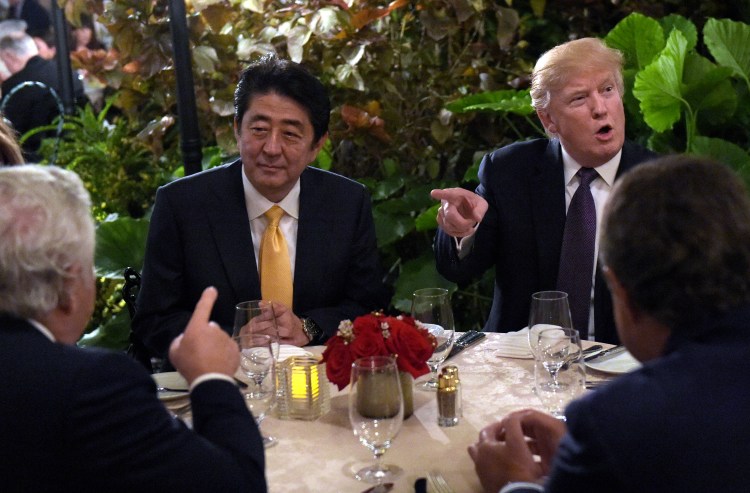Close observers of the 2016 election will remember that, on occasion, President Trump liked to draw attention to his opponent’s security practices as a way of criticism. There was, you may recall, something about an email server.
“Hillary Clinton . . . sent classified information, even during her travels overseas, jeopardizing the national security of the American people by allowing her emails to be hacked by foreign intelligence services,” Trump’s campaign website declared. But it wasn’t just Clinton who was the target of his criticism: The Democratic National Committee got hacked because it didn’t have a “very strong defense system against hacking” the way the Republicans did (as he said during a cybersecurity session on Jan. 31). The government was hacked by China because “we’re run by people that don’t know what they’re doing” (as said in his Jan. 11 news conference). Trump, the idea went, would not be so naive on the critical subject of national security.
Perhaps it’s harder than it looks.
Sunday night, CNN reported details of the moment that Trump, joined by Japanese Prime Minister Shinzo Abe, learned about a missile launch in North Korea. Trump and Abe were enjoying dinner at Trump’s exclusive Mar-a-Lago Club in Florida at the time, but, CNN reported, began to discuss the details of this international incident right there at their table.
“As Mar-a-Lago’s wealthy members looked on from their tables, and with a keyboard player crooning in the background,” CNN’s Kevin Liptak reported, “Trump and Abe’s evening meal quickly morphed into a strategy session, the decision-making on full view to fellow diners, who described it in detail to CNN.”
Earlier in the week, Trump had been criticized for leaving intelligence documents vulnerable to people without security clearance. Sen. Martin Heinrich (D-N.M.) noticed that the president kept the key in a secured bag while hosting people in the Oval Office, which is a bit like leaving your house keys in your front door while you’re having a party in your backyard. There’s no indication that anyone saw anything confidential in this incident, but this, Heinrich suggested, was “Classified 101.”
Compared to holding a national security conversation over dinner in the public dining room at his private club, though, the lockbag incident pales.
It’s not clear that anyone heard particulars of the conversation, but other diners certainly noticed. Richard DeAgazio was in the room and posted photos of the moment to Facebook.
The post has now been made private.
Others who were there added their thoughts in the comments beneath the post. One wrote that he “was watching very close by. Had no idea what it was about.” That’s probably not the case for the waiters, who, CNN reports, “cleared the wedge salads and brought along the main course as Trump and Abe continued consulting with aides.”
The photos appear to corroborate an important detail from the CNN report. “The patio was lit only with candles and moonlight, so aides used the camera lights on their phones to help the stone-faced Trump and Abe read through the documents,” Liptak writes. In DeAgazio’s first photo, you can see a phone flashlight being used in that way.
Why is this important? Mobile phones have flashlights, yes – and cameras, microphones and Internet connectivity. When Edward Snowden was meeting with reporters in Hong Kong at the moment he was leaking the material he’d stolen from the NSA, he famously asked that they place their phones in the refrigerator – blocking any radio signals in the event that the visitors’ phones had been hacked. This was considered the most secure way of ensuring that the phones couldn’t be used as wiretaps, even more secure than removing the battery. Phones – especially phones with their flashes turned on for improved visibility – are portable television satellite trucks and, if compromised, can be used to get a great deal of information about what’s happening nearby, unless precautions are taken.
Precautions weren’t taken. One of DeAgazio’s photos shows Trump using a phone at the table, within view of other diners (and while sitting next to a foreign leader). It’s not clear what phone Trump is using in that picture, but it’s known that he uses a relatively old Android device, even while serving as president. As we noted last week, Trump generally uses that device when he’s not in the middle of a work day. Shortly before the dinner with Abe, he tweeted from it.
The problem is that Trump’s Android phone would be very simple to hack to provide precisely the sort of access described above. NPR dug into the question of how secure that phone might be, and Berkeley computer scientist Nicholas Weaver was blunt.
“Donald Trump for the longest time has been using a insecure Android phone that by all reports is so easy to compromise, it would not meet the security requirements of a teenager,” Weaver told NPR, and while he couldn’t say for sure, “we must assume that his phone has actively been compromised for a while, and a actively compromised phone is literally a listening device.”
That’s just one of the phones that may have been at the table for the conversation.
The picture that’s painted is one that runs contrary to the arguments Trump made on the campaign trail. While running for the presidency, cybersecurity and the risk of compromise were cardinal sins, necessitating that he be given the most powerful position in America. Now that he’s attained that position, though, his attitude toward security seems a bit more lax.
Send questions/comments to the editors.


